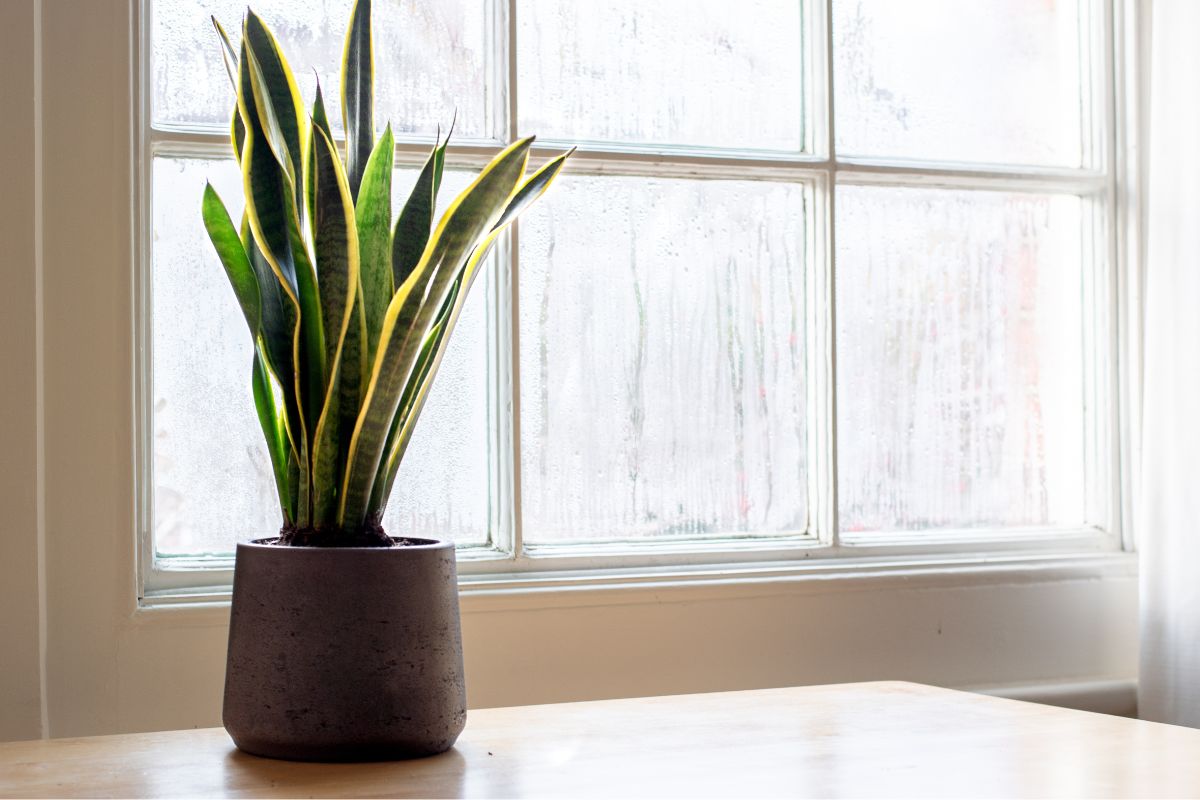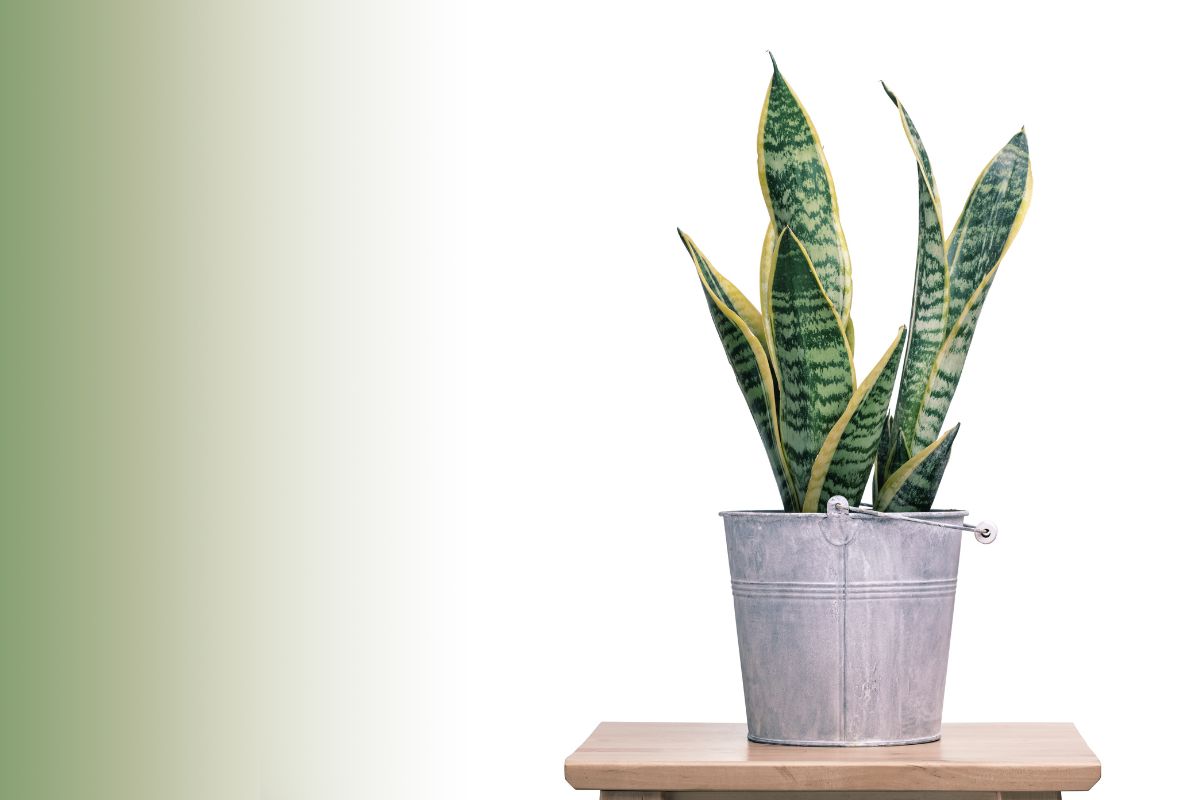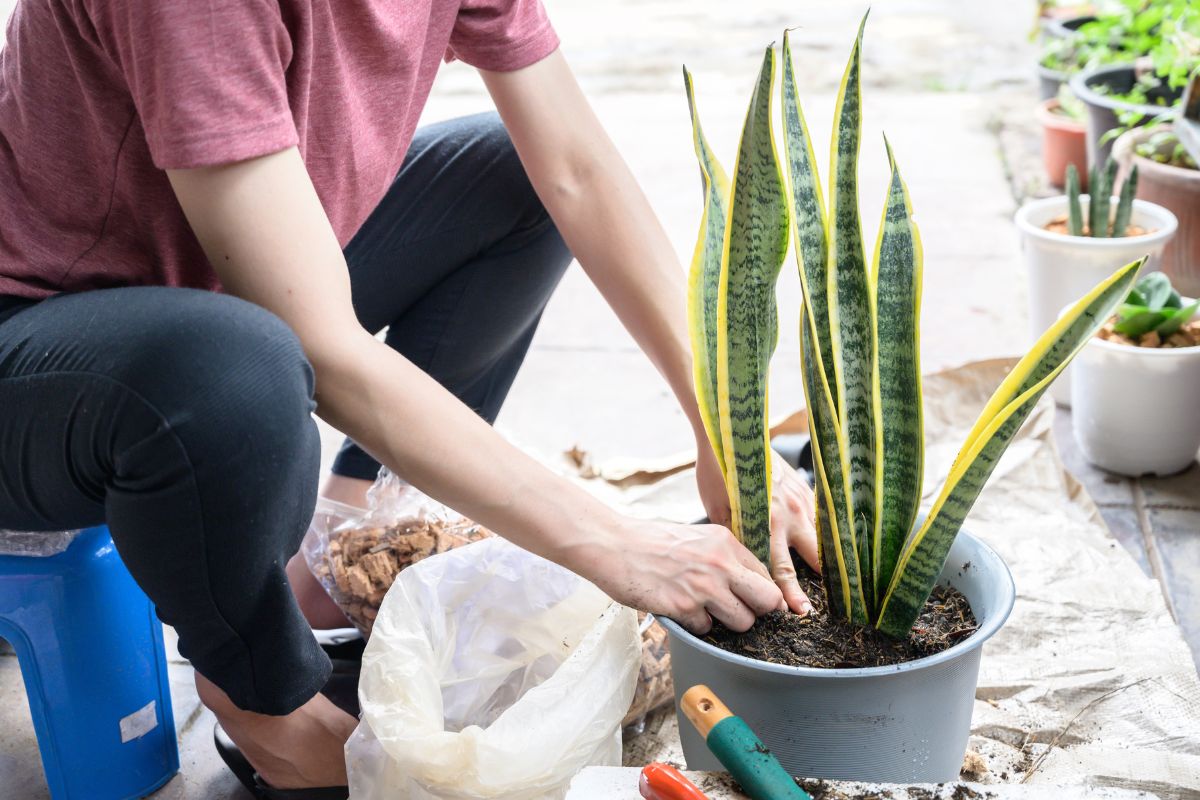The Ideal Temperature for Snake Plants
Snake plants, also known as Sansevierias, are not only incredibly tolerant plants but have a high capacity for growth with little attention. Depending on your environment, you might be wondering, can snake plants live outside?
It is possible to grow snake plants outdoors directly in the soil or on raised pots. However, snake plants need warmer temps to thrive. The ideal snake plants temperature should be between 70° and 90° Fahrenheit (21° and 32° Celsius).

What’s a Snake Plant?
The snake plant is a popular evergreen perennial plant with sword-shaped leaves that look like artificial foliage and grow upright. It comes from the Sansevieria trifasciata family, native to Africa and Asia.
Snake plants are sometimes known as mother-in-law’s tongue. They are well-known for their low maintenance and ability to withstand the most unsuitable cultivation conditions. Snake plants are commonly cultivated as home decor since they appeal to the eyes. Types of snake plants include:
- Dracaena trifasciata ‘Laurentii’ has leaf edges that are a creamy golden color. You cannot multiply this plant by leaf cuttings; you can divide it.
- Dracaena trifasciata ‘Twisted Sister’ is a snake plant species with twisted leaves with yellow margins and horizontal stripes. It gets to a height of around 15 inches (38 centimeters).
- Dracaena trifasciata ‘Hahnii’, popularly known as the bird’s nest snake plant, only reaches a height of six inches. Its leaf clumps resemble a bird’s nest.
- Dracaena pearsonii is sometimes known as rhino grass. It is about 12 inches (30 centimeters) tall and has succulent leaves with a reddish color.
- Dracaena angolensi (Sansevieria cylindrical) has spherical, rigid leaves that can grow several feet long. Outward arcing from a central crown are the leaves.
- Dracaena trifasciata ‘Bantel’s Sensation’ is a snake plant variant with narrow leaves with white vertical stripes reaching around three feet.
What Do Snake Plants Look Like?
As aforementioned, snake plants have tall sword-like leaves, usually dark green with grayish-green horizontal stripes. They also feature a yellow strip along the border of the leaves. Snake plant leaves can grow to a height of 6 to 8 inches (15 to 20 centimeters).
Can Snake Plants Live Outside?
Since snake plants can endure most types of lighting, these plants can live outside and flourish. However, remember they are sensitive to extreme temperatures.
If you intend to keep your Sansevieria outside, ensure you create the right cultural environment that promotes their growth. Additionally, make an exceedingly gradual transition to enable your plant to adapt to the shifting environmental conditions.
Although snake plants can withstand outdoor or indoor climates, keeping them inside during the colder months is preferable, and only moving them outside once the weather warms up. Warm temperatures are ideal for snake plants.
Snake plants are very low-maintenance and don’t need special care instructions; however, there are still a few things you should avoid to ensure your plants grow consistently. By doing this, the plant grows better even if you leave it outside for a long time.
Here are a few things you need to avoid when planting snake plants outside:
Overwatering or Misting Leaves With Water
Contrary to popular belief, snake plants do not require misting. They are incredibly strong; therefore, they can easily survive despite the aridity around them. For those who are unaware, snake plants are excellent water retainers. This indicates that the plants receive enough water through their leaves even during the driest months.
The plant may develop fungus problems if you water it too often. This is likely to affect the quality of the leaves as well.
Ensure your snake plant’s leaves are dry and unbroken even when you water it. Especially as the leaves start to dry up, you could feel the impulse to water the leaves. Watering the plant’s roots would be the best action in this case. For the plant to live longer, don’t mist or overwater it.
Extremely Frigid Conditions
You might not want to buy snake plants if you live in an area with severe winters. If you decide to keep the plant, ensure you put up a suitable heating system before moving your plant outside.
Remember that your snake plant cannot survive below 50° Fahrenheit (12° Celsius). Therefore, keeping the plant in a greenhouse is preferable if you reside in an area with this temperature.
Ignoring Insect Attacks
The strength and tenacity of snake plants are well known. Additionally, they are resistant to pest infestations. Moving it outside, though, is probably going to change the problem. Because of the nearby plants, the plant may become afflicted with pests during this time. Try to take even the smallest forms of infestations carefully to avoid this situation.
Try to resolve the problem as soon as possible by addressing its root. This will maintain the plant’s health and vitality while enhancing its quality.
What is the Hottest and Coldest Temperature a Snake Plant Can Tolerate?
Although there are numerous varieties of snake plants, they are all indigenous to Africa. These regions never experience freezing temperatures because they are warmer. However, different snake plant species have different native environments and related circumstances.
The hottest temperature a snake plant can tolerate is 90° Fahrenheit (32° Celsius), and the coldest temperature it can withstand is 60° Fahrenheit (21° Celsius). In some cases, some snake plant species can withstand up to 104° Fahrenheit (40° Celcius) in the hot summer season and 45° Fahrenheit (7° Celsius) in winter.
Snake Plant Cold Damage Concerns
Snake plants, which are native to tropical Africa, thrive in higher temperatures. They are not cold-hardy plants, even though they can withstand low temperatures of up to 50° to 55° Fahrenheit (10° to 12° Celcius).
Snake plants are far more susceptible to cold damage when left outside or on a balcony throughout the winter. Succulent snake plants have water-storing leaves. When you use icing, the water in plant cells can also freeze. The leaves’ cell walls become destroyed when exposed to subfreezing temperatures.
The damage prevents the movement of nutrients and water through the leaf, which causes the leaves to become dehydrated and die. If your garden soil is dry, the roots will be safe. The plant can, however, perish within a few days if the soil freezes while it is still moist.
Symptoms of Cold Damage
Snake plant leaves may become scarred as a result of cold injury. The plant’s leaves may become limp, mushy, and soft if it receives frosting. They could begin to droop and show light brown bruising or markings. Affected roots also swell and progressively decay away.
Treatment
Low temperatures can permanently harm leaves, and nothing can bring them back to health. If the afflicted leaves make the plant appear unpleasant, the sole solution is to chop them away.
With clean, sharp tools, remove any leaves that have sustained severe damage from the plant. Keep good foliage intact, as over-pruning will put the plant under more stress. If the plant doesn’t have any strong roots, throw it away.

Other Snake Plant Concerns
Fungal Issues
Moist leaves and soils cause fungal issues like red leaf spots and southern blight. You can identify them by the plant’s appearance, particularly the leaves. A common parasitic fungus that affects over 500 plant species, including many houseplants, is the cause of southern blight. Warm, humid environments appear to favor the spread of the disease.
Southern blight rapidly infects the host plant after getting inside. However, external infection-related symptoms start appearing in 7 to 10 days.
Red leaf spot is another typical fungus that can infect snake plants. Although it can infect houseplants all year round, you can frequently see them during the warmer spring and summer months. The young leaves that develop in the center of the rosette are primarily affected by red leaf spots.
Symptoms
You will notice lesions on leaves drenched in water. In later stages, you will see the development of white, cottony web-like vegetation close to the soil line. It finally becomes dark brown and rigid.
In addition to wilting of the leaves, the damaged plant may also have wet, mushy regions of dead plant tissue. Small red or reddish-brown patches on the leaves with a tan center are how you can identify red leaf spots. The patches enlarge and combine over time to become huge, sunken lesions.
Treatment
Use an antifungal or sulfur spray to treat early-stage infestations. Chemical solutions are sometimes used as treatments to stop the spread of the infection; however, they do not completely remove the current infection.
To get rid of the foliar phase of the fungus, it’s crucial to keep the plant dry. To assist stop the spread, completely remove the harmed areas.
Pest Infestation
Although snake plants often do not become infested with pests, they occasionally fall victim to a common bug that wreaks havoc on indoor houseplants. Insects, including mealybugs, thrips, and spider mites, can harm snake plants. Since some of them are so tiny that they are invisible to the unaided eye, it might be challenging to notice them early.
These bugs weaken the plant by sucking its sap and inflicting minor lesions. Mealybugs are soft-bodied, oval-shaped, white insects with a waxy, cotton-like covering all over their bodies. They often live in colonies and can produce up to 100 tiny eggs at once. The most prevalent species of mealybug found on succulent plants like snake plants are the citrus mealybug.
You can easily spot spider mites, which are tiny sap-sucking pests (about 0.03 inches ( 0.1 centimeters) in size), on the undersides of the leaves. To consume the interior fluids, they breach the leaves’ waxy layer. The biggest problem with spider mites is that they reproduce so quickly. Before any obvious signs appear, a severe infestation may exist.
Thrips are tiny, thin insects that feed on all plant sections, similar to spider mites. They can also spread viruses, such as the virus that causes tomato spotted wilt.
Symptoms
Each of these insects leaves behind tiny, obvious wounds on the snake plant leaves. Additionally, mealybugs emit a gooey substance that promotes the development of sooty mold. Thrips may leave behind callused, harsh, or silver-gray scars on leaves.
As the illness worsens, leaves begin to curl, yellow, or develop slowly. The leaves may wilt and fall off at an advanced stage. Additionally, plants can develop tiny, spider-like webs around the base of the plant or in the spaces between the leaves.
Treatment
The best course of action if mealybugs are on a small, localized scale is to personally remove the adults and egg masses. You can clean them using a piece of cloth or cotton swab bathed in rubbing alcohol. Using a water spray to push them away is another option.
The easiest way to get rid of spider mites is to wet the plant and make the area around the plant more humid. The first step is to remove the affected leaves since thrips make leaves yellow and curl. Then use alcohol to remove all of the healthy leaves, making sure to clean every leaf’s fissures and both sides.
Another way to manage the infestation is by using biological control and insecticidal soaps.
Because pest management would take a long time and put other plants in danger of infection, it is advisable to destroy heavily affected plants.
Roots Decay
Root decay brought on by overwatering is one of the most frequent issues that snake plants encounter. This problem is a common occurrence in winter. It may indicate that the plant is getting too much water or that the soil is staying moist for too long.
Wet, saturated soil can suffocate plant roots and make it harder for them to absorb oxygen. The roots cannot absorb the nutrients required for plant growth. The end outcome is increased soil fungus, rotting roots, and plant degeneration.
Symptoms
The problem with root decay is that it frequently goes undiagnosed because the initial symptoms appear below the soil’s surface and are invisible. Healthy roots first appear lighter in color before eventually turning dark brown. This may begin with a small portion of the roots and then spread to the entire root system.
The root’s texture also changes, going from firm to mushy simultaneously. The rot spreads, causing the leaves to become yellow, mushy, and fall out. Rotten roots and foul-smelling leaves can help you identify root decay. In severe circumstances, root rot can quickly kill the entire plant.
Treatment
It is impossible to salvage the plant if most parts of the roots have already turned into a mushy brown substance. Remove it safely from your other healthy plants and dispose of it. Alternatively, you might grow more of it by taking cuttings from the strong leaves.
You can replant your Sansevieria if the decay is not severe. Cut away the mushy, black root regions with sterile pruning shears, reserving just the healthy sections. Remove any damaged yellow leaves. Apply diluted hydrogen peroxide to the remaining roots (1 teaspoon in 0.3 gallons (1 liter) of water) or sprinkle them with cinnamon.
Repot your snake plant in a new container (with drainage holes) with a potting mixture that is clean, dry, and well-draining. Allow the plant to remain in the dry soil for a few days. Then begin watering gently.
How to Grow a Snake Plant Outdoors
Sansevieria temperature tolerance is undoubtedly impressive; the fact that they require very little water to develop is sometimes the toughest challenge they keep up with. If you want to plant your snake plant outdoors, there are fundamental things to consider. Here are some:
Temperature
Snake plant temperature tolerance is mind-blowing. Since they are native to West Africa and Asia, they are tropical plants. As a result, they thrive well in warm climates (USDA Zones 8 through 11), where the temperature ranges from 55° to 90° Fahrenheit (12.7° to 32° Celsius).
So, how cold can snake plants tolerate? Due to their extreme sensitivity to cold weather, they cannot endure temperatures below 50° Fahrenheit (10° Celsius) for more than two days. This will cause snake plant cold damage.
Light
One of the most confusing questions concerning snake plants and light is, can snake plants be in direct sunlight? These plants adjust well to different light variations. Whether heavily light outdoor places, dimly lit or shaded environments are suitable for snake plants.
While you may grow them outside in a garden or a pot, they flourish well in bright, indirect sunlight. It is best to keep them out of direct solid sunlight because prolonged exposure to it might dry them out. Additionally, you should keep your Sansevieria away from dimly lit regions because they might begin to droop leaves and finally dry out.
If you want to grow your Sansevieria outdoors, choose a spot facing south or west so it may get both indirect and direct sunlight daily.
Water
As was already explained, snake plants don’t require much water to live. They don’t need soaked soil. You must water your snake plant as soon as the soil is completely dry. The size of your plant and the humidity levels outside will determine how frequently you need to water them. Usually, two and six weeks is enough time for snake plants to go without water.
Ensure your snake plant is far from other plants that need more regular watering if you’re growing it in the garden outside or a pot by itself (or with other tropical plants).
Examining the leaves is the easiest method to tell whether your Sansevieria plant is too dry. If you see that the leaves are beginning to yellow or seem wilted on the ends, it’s probably time to water the plant.
Soil
Whether you grow your snake plant indoors or outdoors, the soil has good drainage. When putting your snake plant outside in summer, you can use terracotta, ceramic, or porcelain pots. Make sure your pot has sufficient drainage holes, though. Additionally, you may use soil created especially for cactus, succulent, or snake plants.
Repotting
Snake plants are sluggish in growth, and for this reason, repotting is necessary. They might only need repotting every five to ten years if you put them in a dimly lit outdoor area. They could need repotting after two to five years if planted in a location with strong lighting.
They adapt well when you allow their roots to travel freely inside pots. It’s quite natural and won’t impede the plant’s growth if you discover that your outdoor snake plant has gotten more crowded throughout the year’s colder months.
Outside Insects
Snake plants, especially when grown outside, are pest-resistant, another great advantage. But if the environment is not up to some required degree, they might develop a pest infestation like any other home plant.
Mealybugs and spider mites are the most frequent pest species that harm snake plants. If you don’t remove these pests immediately, they may eat the leaves on your snake plant, making it ill and wilted. Rubbing alcohol or applying Neem oil to the leaves of your Sansevieria plant is the most typical method for getting rid of such pests.
How Big Do They Get?
Most snake plant species grow as big as 1 to 3 feet (0.3 to 0.9 meters) tall. However, some species, such as Sansevieria cylindrica, can grow up to 5 feet (0.3 meters) tall.
Planting Snake Plants: A Guide
Pick a pot with a bottom drainage hole. Since terra cotta pots let the soil dry out more readily and faster than plastic pots, they are ideal for growing snake plants. Use a potting mix that drains effectively. It is best to use potting soil intended for “cacti and succulents,” as it will be less likely to become overly wet.
Avoid burying snake plants too deeply when repotting them. You can bury the plant at the same depth as it was in its previous container.
Picking a Spot in the House
Snake plants can handle some direct sunshine but prefer bright, indirect light. However, they also thrive in dark, shaded spaces and other low-light sections of the house, albeit more slowly.
Tip: Relocating your plant too quickly from low light to direct sunlight will shock it. Try to avoid doing this.
When relocating plants, do so gradually. Over about a week, gradually expose the plant to stronger and brighter light. Snake plants require more water in warmer, sunnier places, so be sure to alter your watering practices accordingly.
Maintain the plant in a warm area with a temperature greater than 50° Fahrenheit (10° Celsius). Make sure to shield it from drafty windows in the winter.

The End
Snake plants have a reputation for being tolerant and virtually unbreakable. You can plant them both outdoors and indoors, and they are among the easiest plants to care for. When growing a snake plant outdoors, it’s crucial to keep in mind that the ideal temperature range for the plant is between 70° and 90° Fahrenheit (21° and 32° Celsius) on average.
Snake plants shouldn’t, at the very least, be on low temperatures of less than 50° Fahrenheit (10° Celsius), especially for longer than a few days. However, they can easily resist temperatures as high as 90° Fahrenheit (32° Celsius). Anything higher could harm the plant’s leaves.
